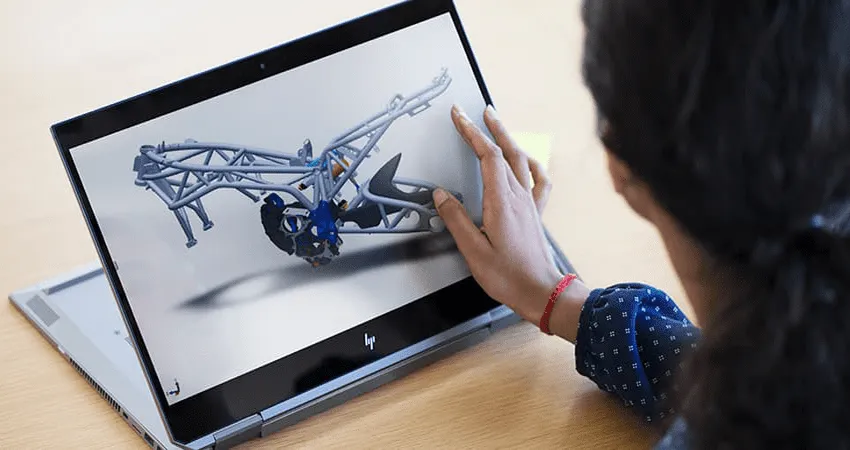Call Us: +91-7042640351, 9891868324
Detailed Guide: Solving HP Touchscreen Laptop Problems
By Admin | 27 Feb 2023

If you're having trouble with your HP Touch Screen Laptop, don't despair – help is at hand. In this article, we'll provide an overview of the most common problems that can arise and offer detailed solutions to help you get your laptop back in working order. Whether it's a touchscreen issue or something else entirely, you should be able to find the answers to your problems here!
What Causes HP Touch Screen Laptop Problems?
There could be several things causing your HP touchscreen laptop problems. It could be a hardware issue, or there could be a problem with the drivers or software. Here are some things to check:
Hardware:
- Check the connections between the screen and the computer.
- Ensure the screen is properly secured and there are no loose cables.
- If you're using an external monitor, ensure it's properly connected and powered on.
Drivers: Check for updates to your touchscreen drivers. You can usually find these on the manufacturer's website. If you're using Windows 10, you can also try updating through Windows Update.
Software: Make sure you're using the latest version of any software installed on your computer. This includes your operating system, as well as any apps that you're using. Remember that some apps may not work properly with a touchscreen, so you may need to find alternatives.
How to Troubleshoot HP Touchscreen Laptop Problems?
If you're having trouble with your HP touchscreen laptop, there are a few things you can do to troubleshoot the issue. First, ensure the touch screen is turned on in the settings. If it is, then try calibrating the touch screen. If that doesn't work, try restarting the laptop and see if that fixes the issue.
If you're still having trouble, you can try a few other things. First, check for any updates for your operating system or the touch screen drivers. If there are, install them and see if that fixes the problem. If not, try resetting the touchscreen calibration in the control panel.
Finally, you can contact HP Service Center in Pune for help if you're still having trouble. They can offer additional troubleshooting tips or help you resolve the issue.

Common HP Touchscreen Laptop Problems and Solutions
If your HP touchscreen laptop is experiencing any of the following issues, this guide will help you troubleshoot and find a solution.
1. The touch screen is unresponsive or not working properly
There are a few things that could be causing this issue. First, make sure that the touchscreen drivers are up to date. If they are, then try restarting the laptop. If the problem persists, try resetting the touchscreen calibration. Go to Start > Control Panel > Hardware and Sound > Devices and Printers to do this. Right-click on your HP laptop's touchscreen device and select Reset from the drop-down menu.
2. The touchscreen is too sensitive or not sensitive enough
Again, this issue can typically be fixed by resetting the touchscreen calibration. If that doesn't work, you may need to adjust the sensitivity settings in Windows 10. To do this, go to Start > Settings > Devices > Touchpad. Here you'll be able to change the sensitivity of your touchpad and enable or disable palm check (which can help with accidental touches).
3. There's a crack or break in the touchscreen
If there's a physical crack or break in the touchscreen, it will likely need to be replaced by HP (or another qualified technician). However, if there's only a small crack or break that doesn't appear to be affecting performance, you can live with it until you can get it fixed.
4. The touchscreen is too hot or too cold
This may be due to poor insulation or ventilation within the laptop's enclosure. Try using a cooling pad or stand to improve ventilation and reduce heat buildup, and make sure that the laptop is not in direct sunlight or near a heat source. You can also try using a laptop vacuum cleaner to remove dust and dirt from the vents.
5. The touchscreen is flickering or displaying strange artifacts
This can be a sign that the laptop's display drivers are outdated or corrupted. Try updating the display drivers by going to Start > Settings > Update & Security > Windows Update and checking for any available updates. If no updates are available, you may need to contact HP technical support for further assistance.
Tips and Tricks for Resolving HP Touchscreen Laptop Problems
If your HP touchscreen laptop is not working properly, there are a few things you can do to try and resolve the issue. First, ensure the touch screen is clean and free of any smudges or fingerprints. If the screen is dirty, it can interfere with the touchscreen's ability to register input properly.
If the screen is clean and you still have issues, try restarting your laptop. Sometimes a simple reboot can resolve software issues that may be causing problems with the touchscreen.
If you're still having trouble, there are a few more advanced troubleshooting steps you can take. One is to update your laptop's BIOS. This can be done through HP's support website; download and install the latest BIOS update for your model laptop.
Another possible solution is to disable or enable certain features in the Device Manager window. To do this, open the Control Panel and navigate to "Hardware and Sound." Under "Devices," select "Device Manager." From here, find the listing for your touchscreen device and double-click it to open its properties window. The properties window will have a check box labeled "Enable Device." If this box is checked, uncheck it and click "OK." Restart your laptop and see if this has resolved the issue. If not, reverse these steps (i.e., check the box instead of unchecking it) and restart.
If you're still having trouble with your HP laptop's touchscreen, you may need to contact HP support for further assistance.
Conclusion
This guide has explored the most common issues people experience with their HP touchscreen laptops. We've discussed how to troubleshoot and resolve them and some tips for avoiding problems in the future. With this information, you are better equipped to keep your HP touchscreen laptop working properly for years. Thanks for reading our guide on solving HP touchscreen laptop problems – we hope it was helpful!
Looking For A Fast & Reliable Laptop Repair Service
We have professional technicians, fast turnaround times and affordable rates. Book Your Repair Job Today!















